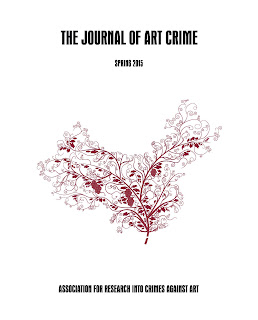Wednesday, July 22, 2015 -  America,cultural treasures,Kirsten Hower,Nazi contraband
America,cultural treasures,Kirsten Hower,Nazi contraband
 No comments
No comments
 America,cultural treasures,Kirsten Hower,Nazi contraband
America,cultural treasures,Kirsten Hower,Nazi contraband
 No comments
No comments
Book Review: Kirsten Hower on "America and the Return of Nazi Contraband: The Recovery of Europe’s Cultural Treasures" by Michael J Kurtz
Kirsten Hower reviews Michael J. Kurtz's "America and the Return of Nazi Contraband: The Recovery of Europe’s Cultural Treasures" in the Spring 2015 issue of The Journal of Art Crime, edited by Noah Charney (with Marc Balcells and Christos Tsirogiannis) and published by ARCA:
Michael J Kurtz’s book, America and the Return of Nazi Contraband, is a breath of fresh air in an often overwhelming branch of cultural heritage history. Focusing on the role that America played in the processes of protecting, recovering, and repatriating the art looted by the Nazis, Kurtz examines the struggles of the bloody quagmire that was World War II. Despite emphasizing the American role in the conflict, Kurtz is resolute in maintaining as much objectivity as possible. He tells history through the groundbreaking achievements, the mundane struggle, and the mistakes of the American restitution effort that had long-standing consequences.
Thorough in nature, Kurtz addresses the origins of wartime looting and the countermeasures from antiquity through World War I, journeying through the troubled times that would prompt the treacherous years of Nazi Germany. The main focus being World War II, Kurtz, Assistant Archivist for Record Services in Washington, D.C., delves into the topic with great detail and fervor, using in-depth archival research to tell the story of the deeply flawed paradigm that was the protection and later restitution of ..cultural objects during this period.
Of particular interest, Kurtz details the tense relationship in the quadripartite powers of the Allied countries in the process of collecting and restituting of artworks stolen by the Nazis during the war. The complications created by countries vying for the immediate return of their cultural property helped create this tense environment that was exacerbated by the secretive and uncooperative attitude of the Soviet Union. While countries such as France and Belgium clamored bitterly to get their cultural property back from the collecting points established throughout Germany, the Soviets demanded harsh reparations for the atrocities committed against their people by the Nazis. Despite the troves of cultural objects that the Soviet Trophy Brigades plundered during the collapse of the Nazi regime, they wanted more. ...
Kirsten Hower is an ARCA Postgraduate Program alum and
has served as ARCA’s Social Networking Correspondent and
List-Serve Manager.



